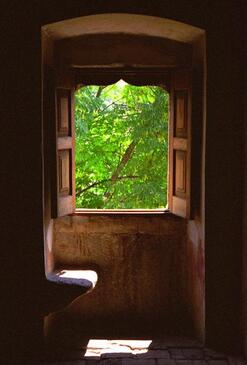|
4/8/2020 1 Comment A Monk’s Guide to COVID-19A Series of Blogs on Surviving and Thriving During Coronavirus Lockdown Although there are many negative and tragic consequences of the present COVID-19 pandemic, there are also many unexpected benefits. Now that I am working from home, for example, I have opportunities to see my family more during lunch breaks, snack time, and quick trips to the loo. I also have fewer distractions and more time on my hands. There’s no commute to work, no digressive chats by the water cooler, no hunting down staplers or office supplies, no neckties or polished dress shoes. Even after work, we have more time: stadiums, theatres, museums, malls have all been shuttered. What to do with the time given to us?
I’m not saying we need to start chanting in Latin, wearing robes and sandals around the house, shaving the tops of our heads, or remaining silent at the dinner table… Nor am I saying we need to retreat from the world and try to create heaven on earth sanctuary. Such are the dangers and pitfuls of historical monasticism. Instead, like the monks, we can carve out daily times for prayer, meditation, and fasting throughout the day. Like Jesus, who retreated to the wilderness for prayer and fasting, we too have a chance to “retreat” for the refreshment of our souls and we, also, can pray ardently for the greatness of God to be made known to our lost world (Matthew 4:1; Luke 5:16). A Modern Monk’s Call to Prayer  While working from home, I find it easy to lose track of time and to work, and work, and work. I also find that there is an explosion of good distractions on social media... seminars, articles, blogs, videos, sermons… So we need to schedule times to pray and to take breaks. Taking scheduled breaks, in fact, is essential to be truly productive. To help with this, I have preset alarms on my phone roughly matched to a handful of monastic prayer times. The alerts on my phone are choral voices singing Latin prayers written during the Middle Ages; I also have one alarm set as church bells… but that’s just me! Do what works for you. I set a pre-break alarm to give myself a five-minute window to finish up tasks before taking a 20- or 30-minute break. I also keep a notepad nearby to jot down “to do” tasks that I don’t want to forget when I get back to work after my break for prayer or rest. Also, note by writing things down, this enables you to forget about whatever you’re working on while taking a prayer or rest break. It’s also important to get up and move away from your work area to a different location. In the next couple of blog posts, I will write about ways to maximize the new monastic lifestyle, I’ll examine aids to prayer, and I will discuss fasting, which John Piper calls “the handmaid of faith.”[1] In the meantime, here are the traditional times of prayer in a monastery.[2] I don’t do Matins (too early), but I do Prime, Terce, Sext, and None. I slightly alter the times to suit my schedule, responsibilities, and commitments.
1 Comment
Your comment will be posted after it is approved.
Leave a Reply. |
Jeremy W. JohnstonChristian, husband, father, teacher, writer. Archives
June 2024
CategoriesAll ANNE BRADSTREET CHRISTMAS COVID 19 CS LEWIS DOUBT EASTER Family Worship FRANCIS SCHAEFFER GUEST BLOG POST JRR TOLKIEN MENTORING MONK'S GUIDE ON ARCHITECTURE ON DEATH ON EXCELLENCE ON HISTORY ON MUSIC ON OLD BOOKS ON POETRY ON THE ARTS ON WRITING PODCAST POETRY PRAYER THANKSGIVING TOLKIEN |



 RSS Feed
RSS Feed
